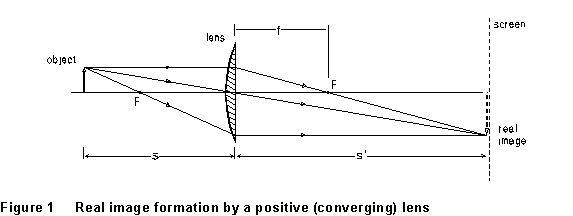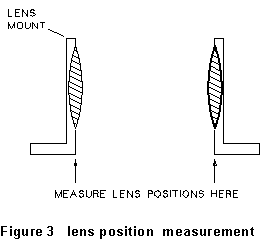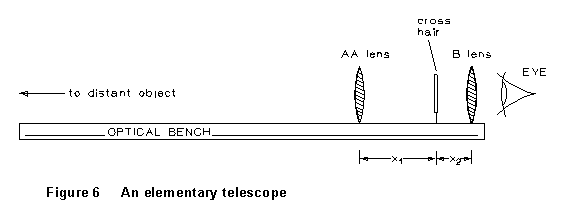
| Table of Contents |
Crummett and Western, Physics: Models and Applications,
Sec. 36-5,6
Halliday, Resnick, and Walker, Fundamentals of Physics (5th
ed.), Sec. 35-6
Tipler, Physics for Scientists and Engineers (3rd ed.), Sec.
31-4
In this experiment, you will encounter some basic characteristics of thin converging and diverging lenses and simple lens systems.

A converging lens bends light incident upon it toward its axis
of symmetry. It is capable of forming a real image, which can be projected
on a screen. In Figure 1, an object is at distance s from a converging
lens whose focal length is f. f is the distance from
the lens at which light from a very distant source (![]() )
is brought to a focus. Nearer objects form real, inverted images at distances
s' > f, as shown in the figure.
)
is brought to a focus. Nearer objects form real, inverted images at distances
s' > f, as shown in the figure.
Conversely, a diverging lens is one which bends incident light away from its axis. Since it does not converge light, it cannot form a real image. However, if one looks through a diverging lens at an object, light from the object comes to the eye as if from an image behind the lens. (See Figure 2.) This image isn't really there, in the sense that there isn't really any point in space from which the rays of light are actually diverging; it is spoken of as a virtual image. Since the image is on the opposite side of the lens from the space in which a real image would be formed, the image distance s' is considered to be negative. A virtual image does not represent a real convergence of light rays and thus cannot be projected on a screen.
A converging lens will also form a virtual image if the object is inside its focal length.

For either a converging or a diverging lens, it is easy to see that, if the thickness of the lens itself is negligible,
 (1)
(1)
where f is considered to be negative for a diverging lens. You can also show that, if y and y' are the heights (measured from the axis) of the object and the image, then
 (2)
(2)
m is called the lateral magnification; negative values of m are interpreted as referring to inverted images.
 The lenses'
mounting in their holders isn't perfectly symmetric, so the best way to
measure a lens position is to record it with the holder turned one way,
repeat it with the holder turned around, and take the average of the two
measurements (see Figure 3).
The lenses'
mounting in their holders isn't perfectly symmetric, so the best way to
measure a lens position is to record it with the holder turned one way,
repeat it with the holder turned around, and take the average of the two
measurements (see Figure 3).
(1) Using converging lens AA (or A), set up as shown in Figure 4. The object is a wire mesh illuminated by a light source behind it. It is the wire mesh you want to form an image of on the screen. Put the mesh at zero on the scale, the screen at 120.0 cm, and the lens in between. Carefully adjust the lens position until a clear image of the mesh is formed on the screen. Record the lens position (as discussed above). Repeat for object-to-screen distances of 150 cm and 180 cm.

NOTE: If you have an A lens instead of an AA, use object-to-screen
distances of 150, 170, and 190 cm.
(2) Repeat step (1) to obtain a second independent determination of the lens position for each object-to-image distance.
(3) Replace lens AA (or A) by lens B and move the screen to the far end of the scale. Record the positions of screen and lens at which you get a clear image of the wire mesh on the screen. Repeat for at least three independent trials. Measure the grid spacing of the wire-mesh object, by counting the number of spacings in a 1-cm (or other convenient) width. Also measure the grid spacing of its image on the screen, in order to find the lateral magnification.

(4) Using diverging lens C and converging lens D, (Don't get fooled into thinking C is for converging and D is for diverging) set up the arrangement of Fig. 5. Set the diverging lens in place from 3 to 8 cm from the object. With an object-to-screen distance of around 80 cm, carefully adjust lens D to form an image on the screen. Record the positions of all system elements (O, C, D, and I). Don't forget Figure 3!) Repeat this procedure twice more.
(5) The focal length of lens D is 10.16 cm. Given this, you have enough information to calculate the focal length of lens C from your data. (Note that the image formed by lens C is the "object" that is imaged by lens D.)

(6) Take the object/lamp box off the optical bench and set up the telescope system of Figure 6. The "eyepiece" lens B should be right at the end of the bench, so you can get your eye close to it without injuring yourself. Aim the telescope at an object as far away as possible. Looking through the B lens, move the cross-hair back and forth until it is in focus. Then move the objective lens AA to bring the distant object into focus. (If you have the cross-hair properly positioned, it and the image will move together when you move your head from side to side a little.) Measure distances x1 and x2. Pick some clearly defined feature of the object, and estimate the ratio of its size when it is viewed through the telescope, to that when it is viewed directly. (There are lots of ways to do this; for instance, let your partner hold a meter stick at the same distance as the object but off to one side, so you can see the object through the telescope, and the meter stick directly, at the same time.)
(1) From your data of steps (1) and (2), use Equation (1) to calculate six values of the focal length of lens A (or AA). Find their mean, standard deviation, and standard error. From your data of step (3), calculate three values for the focal length of lens B, and find their mean and standard error.
(2) One source of error in this experiment is that the position O of the object (the wire-mesh screen) is not very precisely defined. To see how much difference this makes, redo the calculations of (1) with the object distances s increased by 1 mm. Is the change in the answer significant? Do you think it is credible that the position of the object screen is really that far off?
(3) From your data on image and object size in procedure (3), calculate the lateral magnification m from the grid dimensions, m = -y'/y. Compare this to what you get from m = -s/s'. Do the two results agree within your estimates of experimental errors?
(4) Use your data from procedure (4) and (5), and the given value of fD = 10.16 cm, to calculate the focal length of lens C (three independent values). Note that s'C + sD = XCD. (Why?) Find an average value and standard error for fC.
(5) What is your estimate of the apparent magnification of the
telescope in procedure (6) above? For distant objects, the apparent magnification
should be the ratio of focal lengths of the objective and the eye lenses.
Calculate this number and compare to your estimate. For distant objects,
the image formed by the objective (at the plane of the cross-hairs) should
be at the focal point of both lenses, so that ![]() and
and ![]() . How do these
values compare?
. How do these
values compare?
Chapter 6 -- Other Experiments -- Fluid Friction
last update 6/96